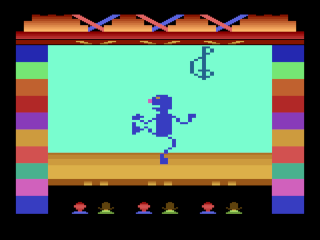|
|
Grover's Music Maker
|
Name:
|
Grover's Music Maker |
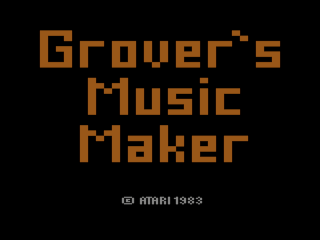 |
| Company: | Atari | |
|
Model #:
|
CX-26106 | |
|
Programmer:
|
Stephan Keith (Programmer & Graphics),
Catherine Keith (Music), and Laura Scholl
(Additional Graphics) |
|
| Year: | 1983 | |
|
Released?
|
No
|
|
|
Notes:
|
Originally called
Monkey Music |
In the early 80's video games were under a lot of scrutiny. It was felt that children were wasting their time playing pointless and violent games. In it an attempt to deflect some of this criticism, Atari proposed making a series of education games starring characters from Sesame Street. Cookie Monster, Oscar the Grouch, Ernie, Big Bird, and Grover were all given their own games in the Children's Computer Workshop Series (CCW). A sixth CCW title called Count's Castle was also planned but never finished. Interestingly Grover's Music Maker was the only game in the CCW series that did not originally star a Sesame Street character. GMM started out life as Monkey Music, which featured a dancing monkey instead of the jumping blue hairball you see today. Eventually the CTW people decided to add Grover to the game in order to make is more marketable, so the monkey was kicked to the curb. It was at this time that graphic artist Laura Scholl was brought in to change the monkey into whatever the heck Grover is supposed to be.
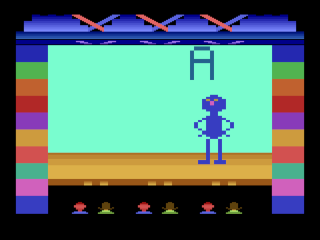
Grover's Music Maker was an attempt by Atari to introduce children to the music through some well known (and some not so well known) children's tunes and the dancing antics of their pal Grover. Selecting one of the 18 letters (20 in some versions), will cause Grover to start dancing like a maniac while some music is played in the background. You'll undoubtedly notice how large and animated Grover is, this is unusual for a 2600 game which due to its limitations made large graphics hard to animate convincingly. But since Grover 'the dancing demon' was the star of the game, they had to make him large enough that he could display all his slick dance moves.
Grover's Music Maker has two different modes of play which are represented by either the treble clef symbol (Recordable Mode) or a letter (built in music). When the treble clef symbol is displayed children can enter in their own sequence of up to 50 notes/moves which Grover will then execute when the '0' key is pressed. If more then 50 notes/moves are entered Grover will shake his head and a little 'no' sound will play indicating that his brain is full. Each of Grover's dance moves (ten in all) has a different note associated with it that will play as Grover dances, so children can either try and make Grover do a silly dance or try and make their own music. The game will also remember how long each key was pressed and have have the length of the note play accordingly (Grover will also hold his pose for as long as the note is held).
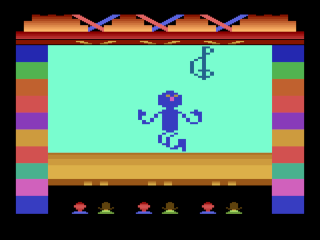
When one of the letters is displayed, pressing the '0' key will make Grover do a dance to one of 18 different tunes. Some of these tunes are fairly obvious (Twinkle Twinkle Little Star, Go Tell Aunt Rhody, Old McDonald Had a Farm, etc.), while others range from the obscure (On the Bridge At Avignon, My Hat Has Three Corners, Bobby Shaftoe), to the unknown (the tunes for letters R and T remain unidentified). Some early prototypes feature two extra tunes (letters S and T) that were removed from later versions. For many years it was assumed that all known versions of Grover's Music Maker were incomplete due to letters U-Z not being present, however it is now known that this is not the case.
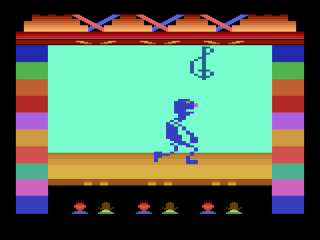
The original Monkey Music prototype used numbers for each tune instead of letters. When the game was changed to Grover's Music Maker the existing variation numbers were changed to letters due to letters Sesame Street having the 'letter of the day' for each episode (This episode brought to you by the letter N). Letters were then assigned to the existing variations, which numbered 20 at the time, so they did not use all the available letters. According to programmer Stephan Keith, there was never any plan to use the whole alphabet, the game was about teaching music, not the alphabet.
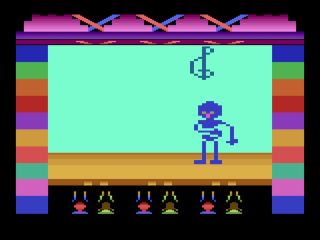
The tunes are:
| A | Old McDonald Had a Farm |
| B | Twinkle, Twinkle, Little Star |
| C | Here We Go Round the Mulberry Bush |
| D | Over the River and Through the Woods |
| E | Hush Little Baby |
| F | The Itsy Bitsy Spider |
| G | My Hat Has Three Corners |
| H | Skip To My Lou |
| I | Three Blind Mice |
| J | Hickory Dickory Dock |
| K | Do You Know the Muffin Man? |
| L | A-Tisket, A-Tasket |
| M | Go Tell Aunt Rhody |
| N | On the Bridge At Avignon (Sur le
pont d'Avignon) |
| O | I'm a Little Teapot |
| P | Go In and Out the Window |
| Q | This Old Man |
| R | ? |
| S |
? |
| T | Bobby Shaftoe |
Although it was shown at the 1983 Winter CES show and artwork was commissioned, Grover's Music Maker was cancelled later that year. According to Stephan, he actually asked the CTW people to cancel the game because he felt that it would not be successful due to the limits of the technology (it was felt that only being able to store 50 notes/moves in Recordable Mode wasn't enough) and that the game would not recoup the cost of producing the cartridges. There were also issues with the children they brought in to playtest the game having trouble using the large and unwieldy Kid's Controller which caused them to lose interest in the game after a short while. This is unfortunate as Grover's Music Maker is an interesting attempt at a genre not covered by any other 2600 game and is quite amazing from a technical standpoint. Keith ported Grover's Music Maker over to the Atari 800 as a proof of concept to show how the game would be improved on more power hardware, but this version was also shelved.
Prototype Box
| Version | Cart Text | Description |
| 8/18/82 |
Monkey Music EPROM Cartridge 8-18 |
Early version featuring a monkey |
| 10/27/82 | Grover 10-27-82 | |
| 11/21/82 |
Grover's Music EPROM Cartridge 21/Nov/82 |
|
| 12/29/82 |
Grover 12-29-82 |
Has extra tunes/letters (S and
T) |
| 1/18/83 |
Grover 1-18-83 |
Final version? |

